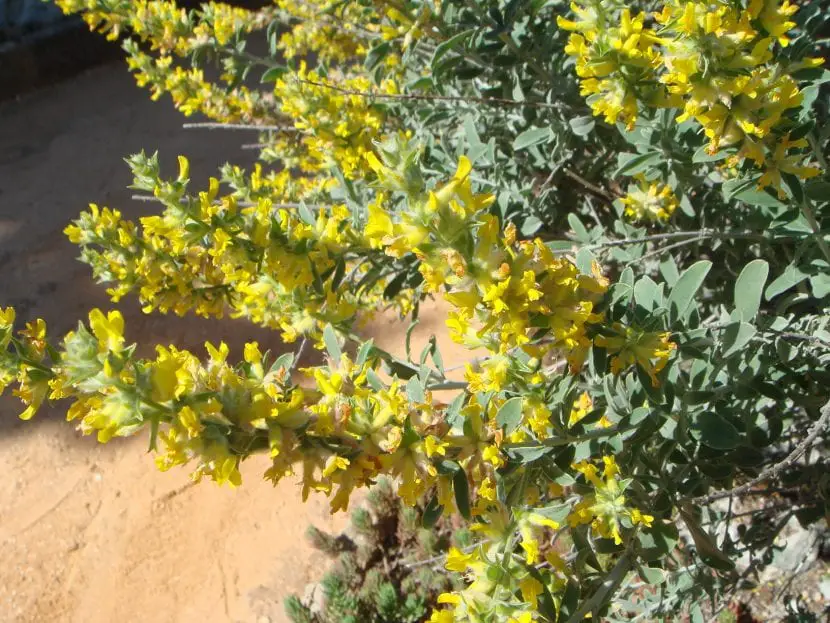
When you live in an area where rainfall is rather scarce, it is important to look to find plants that adapt well, that is, that once planted in the garden or after a few months they are able to live without anyone taking care of them. as the Anthyllis cytisoidesbetter known as albaida.
This is a plant that we will normally find growing naturally in the Iberian Peninsula, but it is so beautiful that from here I encourage you to get some seeds or seedlings in a nursery or online gardening store. To tell you its characteristics and its care, we will take care of it below.
Origin and characteristics of Anthyllis cytisoides

Our protagonist it is a subshrub native to the Mediterranean region (from Catalonia to Cádiz, Balearic Islands, North Africa) and also from South Africa known by all these common names: albada, albaida, Castilian albaida, albaira, albayda, algaida, arbaira, blanquilla, boja blanca, cañamillo, iboja blanca, soap dish, mata blanca, mount blanco, matillas white, and by the scientist Anthyllis cytisoides.
Reaches a height of up to 90 centimeters and it is highly branched, so much so that it acquires a rounded shape. The leaves are trifoliate, green in color, and the flowers appear grouped on the branches and are yellow. Blooms in spring (between April and May in the northern hemisphere). The fruit is a legume that finishes maturing in mid-summer.
Grows in limestone soilswhere drought is usually one of the biggest problems in the area. For this reason, it is a very interesting species for xero-gardens.
What are their cares?
Would you like to get a copy? Follow our tips to make it grow precious:
Location
You have to place your albaida in an area where it is exposed to direct sunlightsince it does not adapt to semi-shade.
Earth
- Flower pot: You can use universal growing medium mixed with 30% perlite or washed river sand.
- the garden: the soil must be limestone, with a pH between 7 and 8.
Irrigation
- Potted: one or two irrigations per week.
- In the garden: During the first year it will need one or two weekly waterings, but from the second it will not be necessary to water it more as long as about 300mm of rain falls per year.
Subscriber

Guano powder.
From early spring to late summer it will be highly recommended -although not mandatory- pay the Anthyllis cytisoides with Organic fertilizersAs guano o manure once a month or every two months. A handful is spread around the plant, mixed with the top layer of the earth, and watered.
In the case of having it in a pot, it will be better to use liquid organic fertilizers so as not to hinder the rapid drainage of the water.
Planting or transplanting time
The best time to plant it in the garden or move it to a larger pot, something that by the way has to be done every two years, it’s in springwhen the risk of frost has passed.
Plagues and diseases
It’s very tough. You don’t have to worry about this issue.
Pruning
Act quickly. remove withered flowers and dry leavesas well as those branches that look sick, weak or broken.
Multiplication

The Anthyllis cytisoides or albaida multiplies by seeds following this step step:
- The first thing to do is to collect the legumes as soon as they mature.
- Afterwards, you have to proceed to clean the seeds by pouring them into a glass of water.
- Next, we prepare the seedbed (pot, seedling trays, glasses of yogurt, milk containers, … whatever we prefer) filling it with universal culture substrate.
- Then we spread the seeds on the surface of the soil and cover them with a thin layer of substrate.
- Finally, we water and place the seedbed outside, in full sun.
The first will germinate in spring.
Rusticity
Albaida is a plant that it resists well frosts down to -5ºC.
What uses does it have?
Ornamental
As you have been able to see in this article, it is a plant with a high ornamental value. It produces so many flowers that it is wonderful to see it. In addition, when growing as a subshrub of about 90cm in height can be used for borders or low hedges in the gardenthe for decorate the patio or balcony planted in a nice pot.
Medicinal
It is indicated for asthma and coldsbut it should only be taken after consulting a doctor since in high doses it is toxic.
Other uses
- Can be used as firewood to make a fire, for example, to prepare a torrada.
- Also like brooms for occasional use.
- The thin, smooth and flexible branches to make the frames used in silkworm rearing.

What did you think of Anthyllis cytisoides? Have you ever seen it? If you are looking for a very drought resistant plant that is also beautiful, without a doubt this is one of your best options.


2 thoughts on “Anthyllis cytisoides or albaida, a beautiful and resistant plant”